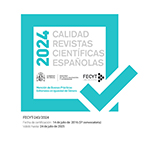El tránsito al empleo de las personas más desfavorecidas a través de las empresas de inserción
Resumen
En este artículo analizaremos como en estos últimos años, gracias a la experiencia acumulada y a la sistematización metodológica alcanzada, las empresas de inserción (EIS) se han convertido en una herramienta muy eficaz para la integración social y laboral de las personas con más dificultades de nuestra sociedad.
Desde nuestra visión, las empresas de inserción no se pueden concebir como un fin en sí mismo, y para que desarrollen todo su potencial deben están insertas en lo que se ha ido configurando como itinerario de inserción sociolaboral; es decir: un recorrido singular adaptado a las necesidades de cada persona en situación de exclusión social que pasa por unas acciones de formación, de acompañamiento y de acceso al empleo.
Las personas en procesos de inserción dentro de estas empresas empiezan a experimentar la sensación de ciudadanía plena y a tomar conciencia, como trabajadores y trabajadoras, de que contribuyen como una persona más, con sus impuestos y sus cotizaciones, al pasar de percibir un subsidio a cobrar un salario.
Veremos también como estas empresas tienen la virtud de generar beneficio social —cohesionando los territorios y a las personas— a la vez que contribuyen a generar una economía productiva, ya que no dejan de ser organizaciones que están en el mercado ordinario ofreciendo productos y servicios.
Por último destacaremos el ahorro que supone a las arcas públicas el funcionamiento de las empresas de inserción, cuyas inversiones aunque relativamente modestas consiguen un retorno a las administraciones públicas; actualmente, de más de 6.000 euros por puesto de inserción, en concepto de Seguridad Social, IRPF, IVA, Impuesto sobre Sociedades y otros tributos.
Descargas
Descarga artículo
Licencia
La revista Cuadernos de Trabajo Social, para fomentar el intercambio global del conocimiento, facilita el acceso sin restricciones a sus contenidos desde el momento de su publicación en la presente edición electrónica, y por eso es una revista de acceso abierto. Los originales publicados en esta revista son propiedad de la Universidad Complutense de Madrid y es obligatorio citar su procedencia en cualquier reproducción total o parcial. Todos los contenidos se distribuyen bajo una licencia de uso y distribución Creative Commons Reconocimiento 4.0 (CC BY 4.0). Esta circunstancia ha de hacerse constar expresamente de esta forma cuando sea necesario. Puede consultar la versión informativa y el texto legal de la licencia.









